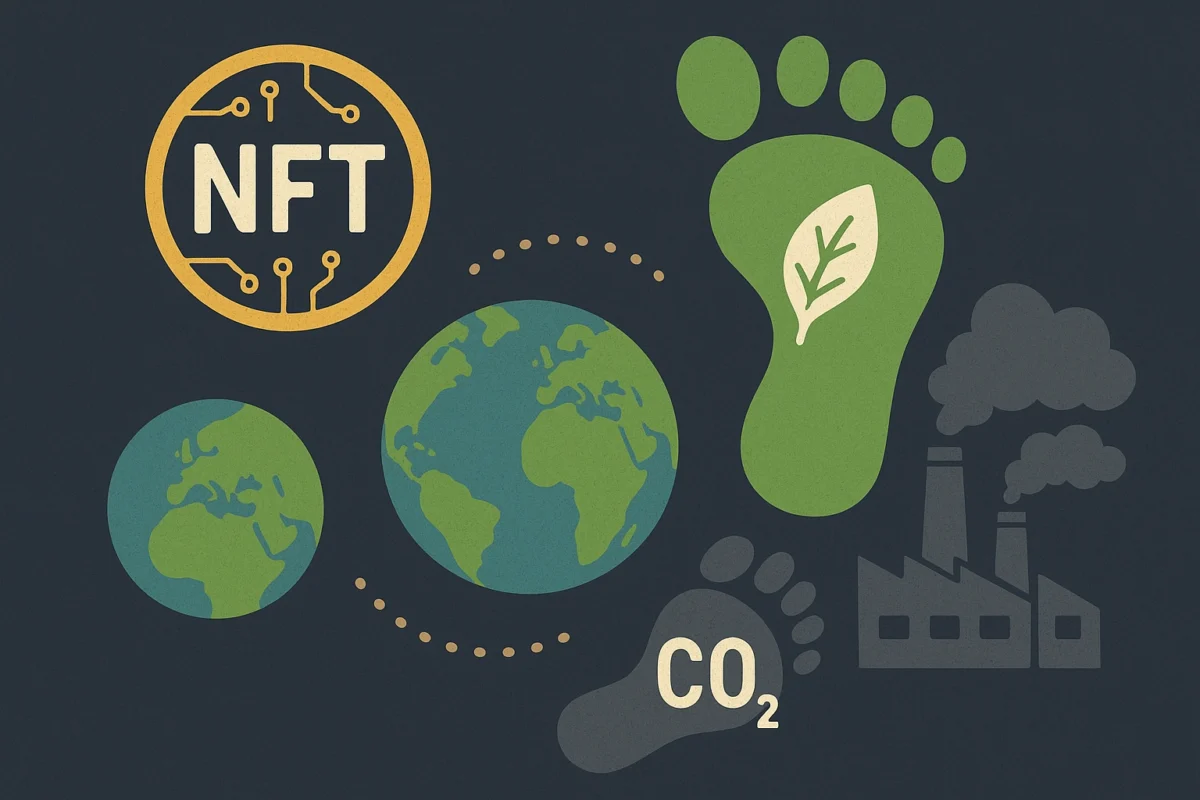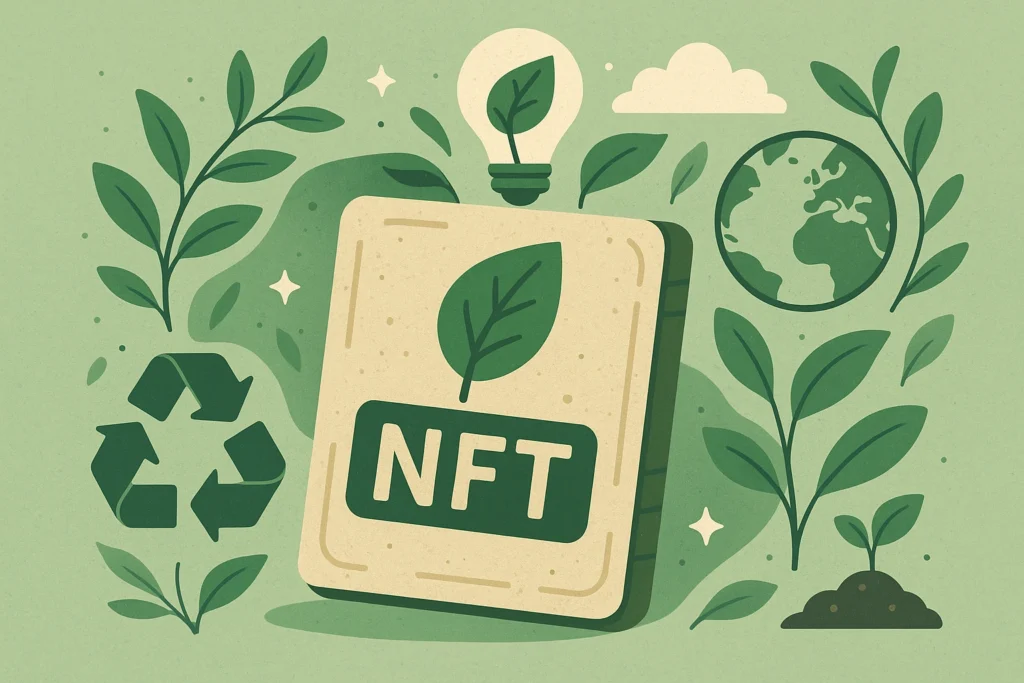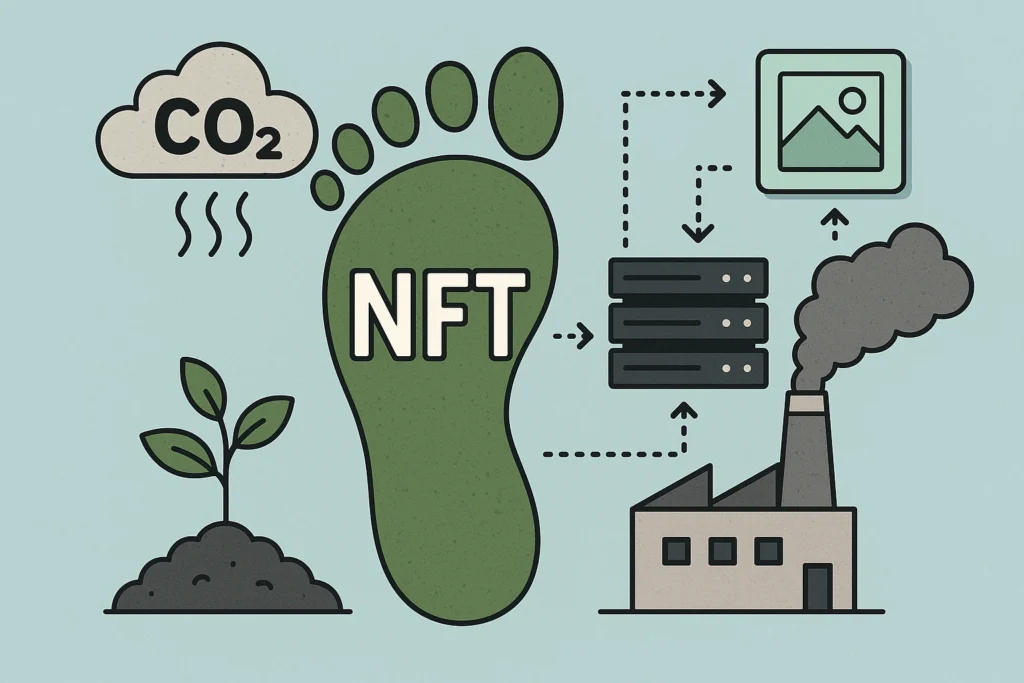Understanding NFT Carbon Footprint: Eco-Friendly Blockchain Innovations

When NFTs exploded in popularity, they ignited a massive global debate. Sure, we were talking about digital art and ownership, but we also quickly had to face the environmental question. The truth is, every single NFT transaction like minting, buying, or selling carries a carbon footprint. This NFT carbon footprint or high energy consumption has been the sharpest criticism of the whole blockchain world.
But the narrative is shifting. With the rise of eco-friendly NFTs and major steps forward in blockchain sustainability, everyone from artists to collectors to major platforms is finding solutions to make the digital economy cleaner. We’ll explore exactly how the NFT’s environmental impact is calculated, why it’s so important, and the green technologies that are currently reinventing the future of blockchain.
What Is the NFT Carbon Footprint?
An NFT’s carbon footprint refers to the greenhouse gas (GHG) emissions generated during its creation, transfer, and storage on a blockchain. The majority of emissions come from the consensus mechanism a blockchain uses to validate transactions. It includes:
Proof of Work (PoW): Used by early blockchains like Ethereum, PoW relies on energy-intensive computations. Each NFT transaction required significant electricity.
Proof of Stake (PoS): A newer, greener model where transactions are validated by token holders. It slashes energy usage by over 99%.
Understanding this difference is essential because NFT emissions are tied directly to the underlying blockchain tech.
Why NFT Carbon Footprint Matters
The NFT market has scaled rapidly, and so have its environmental consequences. The concerns are not just about optics, they are scientific and economic realities like:
Environmental Responsibility: Artists and collectors want assurance their digital creations don’t harm the planet.
Market Reputation: Platforms that ignore sustainability risk backlash from eco-conscious users.
Regulatory Pressure: Governments are pushing for carbon reporting across industries, including blockchain.
Investor Interest: ESG-minded investors are more likely to fund sustainable crypto projects.
Also See: What is a Treasure NFT and Why Should You Invest?
Innovations Driving Eco-Friendly NFTs
1. Transition to Proof of Stake
Ethereum’s 2022 “Merge” cut its energy use by over 99%. This shift to PoS set the tone for eco-friendly NFTs and inspired similar moves across blockchain networks.
2. Carbon-Neutral Blockchain Projects
Blockchains like Tezos, Flow, and Algorand are designed to be carbon-efficient from the start. They require less computing power and integrate carbon-neutral blockchain strategies into their design.
3. Renewable Energy Mining
Some platforms are offsetting emissions by investing in renewable energy. Instead of fossil fuels, servers run on solar, hydro, or wind power.
4. Carbon Offsets for NFTs
Marketplaces like Nifty Gateway and Aerial offer NFT emissions offsets. Buyers and sellers can automatically contribute to verified carbon removal projects each time they trade.
5. Layer 2 Scaling Solutions
Layer 2 technologies like Polygon process transactions off the main blockchain, reducing energy use per transaction while maintaining security.
6. Eco-Conscious Marketplaces
Specialized NFT marketplaces are emerging with a sustainability-first ethos. They market themselves as platforms for green NFTs to attract eco-aware audiences.
Measuring and Tracking NFT carbon footprint

Just as industries track Scope 1, 2, and 3 emissions, NFT ecosystems require precision tools. Platforms are increasingly turning to:
NFT Carbon Calculators: Tools that estimate emissions per NFT mint or trade.
Blockchain Sustainability Dashboards: Real-time reports on network energy use.
Third-Party Verifiers: Independent organizations that certify NFT environmental impact data.
This transparency helps creators and collectors make informed choices.
Benefits of Eco-Friendly Blockchain Innovations
For NFTs, this shift to eco-friendly blockchain innovations means it changes how creators, investors, and collectors perceive value. Here’s how clean blockchain design is reshaping the NFT ecosystem:
Reduced Carbon Footprint
The most obvious benefit is the sharp drop in emissions. Traditional proof-of-work blockchains consumed as much energy as small countries. By moving to proof-of-stake and carbon-neutral blockchains, energy demand falls by more than 99%.
Increased Market Trust
Reputation plays a huge role in the NFT space. Artists and platforms associated with high emissions often face criticism, which can hurt sales and adoption. By switching to green NFTs, platforms demonstrate responsibility and transparency. Buyers are more likely to trust eco-conscious marketplaces, knowing their purchases align with sustainability values.
Lower Transaction Costs
Sustainability often comes with an economic bonus. Many eco-friendly blockchains not only consume less energy but also reduce transaction fees, commonly known as gas fees. Lower costs make NFTs more accessible to emerging artists and casual collectors. Over time, this opens the market to a wider community and helps grow adoption beyond high-value investors.
Broader Adoption
Environmental criticism has been one of the biggest barriers to mainstream adoption of NFTs. Industries like fashion, gaming, music, and sports want to leverage blockchain but don’t want to be tied to negative climate press.
Eco-friendly blockchains remove that obstacle. As a result, more global brands are beginning to experiment with NFTs as part of their digital strategies, from luxury collectibles to virtual gaming assets.
Long-Term Compliance
Regulation is tightening around emissions disclosure. Businesses across industries are being asked to report their environmental footprint. It’s only a matter of time before blockchain platforms are held to the same standard. By embracing sustainable crypto practices now, platforms avoid the scramble later. They stay ahead of compliance demands, attract ESG-focused investors, and show leadership in shaping responsible digital markets.
Future of Clean NFTs

The next era of NFTs will not just be about rarity or community—it will be about responsibility. Expect to see:
Standardized Emissions Labels: NFTs may come with verified carbon footprint tags, like nutritional labels for food.
Integration with ESG Frameworks: Platforms aligning with sustainability reporting standards.
Cross-Industry Collaboration: Partnerships with renewable energy providers and climate tech startups.
User Education: Platforms guiding collectors on the impact of their purchases.
FAQ: NFT carbon footprint
Are all NFTs bad for the environment?
No. The environmental impact depends on the blockchain. Green NFTs on PoS or carbon-neutral blockchains have far lower footprints.
Can NFTs become carbon-neutral?
Yes. With carbon offsets, renewable energy, and efficient blockchains, NFTs can achieve carbon neutrality.
Which blockchains are most eco-friendly?
Tezos, Flow, Polygon, and Algorand are popular choices for sustainable crypto projects.
How do NFT carbon calculators work?
They estimate emissions based on energy used during minting and transaction validation.
Conclusion
The debate around the NFT carbon footprint highlights a broader truth: sustainability will define the future of digital assets. Through eco-friendly NFTs, carbon-neutral blockchain innovations, and transparent emissions reporting, the industry is showing it can evolve responsibly. Clean, sustainable NFTs aren’t just possible—they’re already here. For creators, collectors, and platforms, the message is clear: the future of blockchain is green.